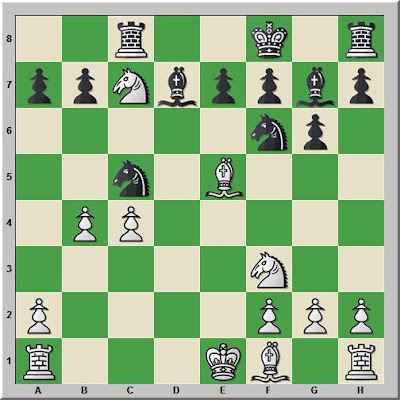Chess Tempo performance statistics give me percentage scores for my performance on each of the tactical motifs it recognizes. My lowest percentage after the first several hundred problems was in Counting, which CT defines as, "a tactic occurring due to a mistake in evaluating the material balance arising after a series of takes." After identifying this weakness, I created a problem set consisting of all the Counting problems rated 1600-2000. A portion of my training each week has been with this problem set.
This work paid off in a critical position yesterday. I was playing David Griffin in the Spokane City Championship Contenders Tournament. Griffin organizes and funds this remarkable event. Participants must be invited. The participants are selected through a grand prix points system after those winning local weekend tournaments and twice annual club championships have taken the first slots. It is a six player round-robin event. The winner becomes the challenger in a four game City Championship match.
In 2008, I won this event and then lost to FM David Sprenkle 2 1/2 - 1/2 in the championship. In 2010, I tied John Julian in the Contenders Tournament, but he had better tie-breaks. Julian played Sprenkle, losing. Sprenkle then moved out of state due to employment opportunities elsewhere, and in 2011, Julian played Michael Cambareri in the championship match. Julian is the current city champion.
This year's Contenders includes Griffin, the lowest rated player; Tim Moroney, an Expert and the highest rated player at present in our fair city; Cambareri, Jeremy Krasin, Nikolay Bulakh, and me, all in the 1900s USCF. Although ostensibly the weakest player, Griffin is well-experienced and capable of beating any of the rest. He drew Moroney in their encounter.
We left the main traveled paths rather quickly, as both players opted for uncommon moves. My seventh move rendered the game unique in the annals of chess history, but already by that point we had departed from the play of anyone over 2100.
Griffin,David (1611) - Stripes,James (1933) [A31]
City Championship Contenders Spokane, 08.06.2012
1.d4 Nf6 2.Nf3 c5 3.c4 g6 4.Nc3 cxd4 5.Nxd4 Bg7 6.Bf4?! d6 7.Nf3 Qc7N
7...0–0
White to move
8.e4 Nbd7 9.Qd2 Nc5 10.e5 dxe5?!
10...Nfe4 11.Nxe4 Nxe4 12.Qd5 Nc5 =
11.Bxe5 Qd7 12.Qxd7+
12.Qe3 +/=
12...Bxd7 13.Nd5 Rc8 14.Nc7+?!
14.Rd1
14...Kf8 15.b4?
Defining Counting as an error in calculation, Griffin's assault on this knight was a critical error in the game. It led to a position that I spent four minutes studying before making my move, my second longest think in the game. I was playing relatively fast, using a total of forty minutes for the whole game. Griffin used eighty.
Black to move
15...Ng4! -/+
I played the strongest move, which was the result of confident calculation of a series of exchanges. Confidence during the game stemmed from the hours of training on Chess Tempo. Also of concern was that moving my knight to safety permits white to start rolling his queenside pawn majority, and thereby freeing his light-squared bishop for action. I had a clear advantage from this point on in the game. Even so, Griffin found a way to make things interesting, and one or two inaccuracies on my part gave him opportunities, the most important of which he kindly failed to exploit. In the end, he overlooked a checkmate threat.
16.Bxg7+ Kxg7 17.bxc5
During my calculation for move 15, I had to examine 17.Nb5 Bxb5 18.cxb5 Ne4 19.Be2 Nexf2–+. I did not continue my calculations to consider 20.0–0 Ne4.
17...Rxc7 18.h3
18.Rb1 Nf6–+
18...Nf6–+ 19.Rb1
Black to move
19...Bf5?!-/+
19...Ne4-+
20.Rb5 Nd7 21.Nd4
Nothing can be done to save the bishop, but my knight is better than his bishop even in this relatively open position. However, the doubled pawns and open g-file gave my opponent play that easily could have been prevented. Black still has a clear advantage.
21...Nxc5 22.Nxf5+ gxf5 23.h4 Rd8 24.Rh3 b6 25.Rg3+ Kf6 26.Rg5 e6 27.Be2
Black to move
27...Ne4
I spent about three minutes considering the relative merits of the text move and 27...Rcd7. Possible the latter was more accurate. Rybka prefers the move that I played.
28.Rh5 Kg6 29.g4 Nc3?
I failed to even consider 29...fxg4, the correct move.
White to move
30.gxf5+ Kg7! 31.Re5 Rcd7? 32.fxe6??
We spent some time after the game examining the rook endgame after 32.f4 Nxe2 33.Kxe2 Rd2+. Black is better. White could have played 32.Kf1! when Black's advantage is slight.
32...Rd1+ 0–1
Next move is checkmate.



















I've been looking for counting problems and until now didn't realize that they were recognized as a tactics type at Chess Tempo and could be sorted into a separate tactics set. Thanks!!!
ReplyDeleteGlad to help. Thanks for leaving a comment.
Delete